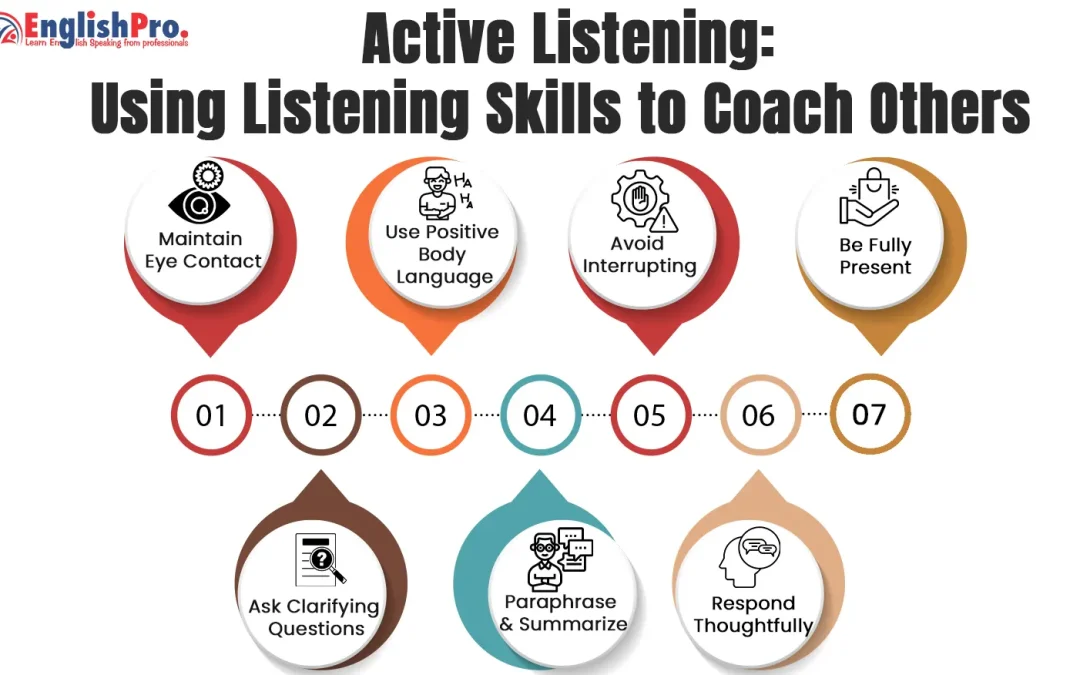Introduction
The ability to communicate effectively becomes essential in a fast-paced professional environment. The practice of active listening serves as a fundamental tool to create meaningful conversations and establish strong connections. Active listening demands not only hearing the spoken words but also requires full concentration and understanding followed by appropriate responses to the speaker. Developing strong active listening skills will enable managers, coaches, and mentors to provide better guidance and support to individuals they work with. The article examines essential active listening strategies while emphasizing their coaching benefits and provides methods for everyday conversation implementation.
Understanding Active Listening
Active listening refers to a communication method designed to fully engage with what a speaker is saying. Active listening demands intentional effort while passive listening involves hearing information without true processing. The key elements of active listening include:
Giving Full Attention: Use facial expressions along with eye contact and nodding to demonstrate your engagement.
Avoiding Interruptions: Wait until the speaker has concluded their thoughts before you respond.
Reflecting and Paraphrasing: Paraphrase the speaker’s words to ensure comprehension is accurate.
Asking Open-Ended Questions: Encourage deeper discussion by prompting further insights.
Providing Feedback: Building trust requires recognition of emotions and validation of concerns.
Why Active Listening Matters in Coaching
Leadership requires coaching as an essential element because active listening serves as a fundamental key to achieving its success. Through active listening, coaches create supportive environments that promote personal growth and confidence development. The benefits include:
| Benefit | Explanation |
|---|---|
| Enhances Understanding | Helps coaches grasp the true concerns and needs of the individual. |
| Builds Trust | Demonstrates empathy and respect, strengthening relationships. |
| Encourages Problem-Solving | Promotes collaborative discussions for finding effective solutions. |
| Boosts Motivation | Validates feelings and thoughts, increasing the individual’s drive to improve. |
| Reduces Miscommunication | Minimizes misunderstandings by ensuring clarity and alignment. |
Techniques for Effective Active Listening
Implementing active listening requires practice and awareness. Here are some effective techniques:
1. Maintain Positive Body Language
The way you communicate without words plays an essential part in how you interact with others. Display attentiveness by positioning your body openly while making occasional nods and sustaining visual connection through eye contact.
2. Use Reflective Listening
Reflective listening lets you verify your correct understanding of the speaker’s message. For example:
You seem to be experiencing an overwhelming amount of work. Is that correct?”
Through this technique speakers receive reassurance while gaining the opportunity to articulate their thoughts more clearly.
3. Avoid Jumping to Conclusions
Jumping to conclusions about what the speaker means often results in misunderstandings. Pause your response until the speaker completes their thoughts.
4. Ask Thought-Provoking Questions
Invite the speaker to expand on their ideas through questions like:
What difficulties are you encountering in this situation?
“How do you feel about this decision?”
5. Practice Empathetic Listening
Strengthening relationships becomes possible through empathy because it demonstrates your real interest in understanding the speaker’s viewpoint. Acknowledge their emotions by saying:
I can see why this situation would cause you frustration.
Implementing Active Listening in the Workplace
Active listening techniques are useful in different workplace settings including individual meetings and group discussions. Here’s how it can be integrated effectively:
During Performance Reviews
Through active listening, managers gain insights into employee issues while acknowledging their successes and offering useful guidance.
In Conflict Resolution
Active listening enables leaders to mediate conflicts and reach solutions that benefit all parties involved without any bias.
In Team Meetings
Team members who share their thoughts openly help create collaborative environments that lead to innovative solutions.
Overcoming Common Listening Barriers
Active listening remains essential for meaningful communication but faces several obstacles that make it difficult to practice effectively. Here’s how to overcome them:
| Barrier | Solution |
| Distractions | Eliminate background noise and maintain focus on the speaker. |
| Preconceived Notions | Approach conversations with an open mind. |
| Emotional Reactions | Manage personal biases to listen objectively. |
| Time Constraints | Allocate dedicated time for meaningful discussions. |
Professionals need active listening skills to succeed in coaching roles and leadership positions while growing their careers. Through intentional listening practice and positive body language maintenance along with thoughtful responses, individuals can improve their communication effectiveness. Active listening strengthens bonds between individuals and builds a foundation of trust and teamwork in performance evaluations, conflict resolution, and team discussions.
Consider examining Top HR Interview Questions and Answers for 2025 to boost your communication skills when you prepare for career advancement. Learning how to actively listen can improve your coaching skills while simultaneously generating a workforce that demonstrates increased engagement and motivation.


Recent Comments